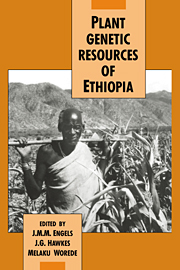Book contents
- Frontmatter
- Contents
- Contributors
- List of acronyms
- Preface
- Part I General introduction
- Part II The Ethiopian centre of diversity
- Part III Germplasm collection and conservation in Ethiopia
- Part IV Evaluation and utilization of Ethiopian genetic resources
- 18 Germplasm evaluation with special reference to the role of taxonomy in genebanks
- 19 Crop germplasm multiplication, characterization, evaluation and utilization at PGRC/E
- 20 Evaluation methods and utilization of germplasm of annual crop species
- 21 Evaluation and utilization of Ethiopian forage species
- 22 Improvement of indigenous durum wheat landraces in Ethiopia
- 23 Use of germplasm resources in breeding wheat for disease resistance
- 24 Indigenous barley germplasm in the Ethiopian breeding programme
- 25 The role of Ethiopian sorghum germplasm resources in the national breeding programme
- 26 Germplasm evaluation and breeding work on teff (Eragrostis tef) in Ethiopia
- 27 Pulse crops of Ethiopia: genetic resources and their utilization
- 28 Oil crop germplasm: a vital resource for the plant breeder
- 29 Significance of Ethiopian coffee genetic resources to coffee improvement
- 30 Use of Ethiopian germplasm in national and international programmes
- Index
26 - Germplasm evaluation and breeding work on teff (Eragrostis tef) in Ethiopia
Published online by Cambridge University Press: 30 October 2009
- Frontmatter
- Contents
- Contributors
- List of acronyms
- Preface
- Part I General introduction
- Part II The Ethiopian centre of diversity
- Part III Germplasm collection and conservation in Ethiopia
- Part IV Evaluation and utilization of Ethiopian genetic resources
- 18 Germplasm evaluation with special reference to the role of taxonomy in genebanks
- 19 Crop germplasm multiplication, characterization, evaluation and utilization at PGRC/E
- 20 Evaluation methods and utilization of germplasm of annual crop species
- 21 Evaluation and utilization of Ethiopian forage species
- 22 Improvement of indigenous durum wheat landraces in Ethiopia
- 23 Use of germplasm resources in breeding wheat for disease resistance
- 24 Indigenous barley germplasm in the Ethiopian breeding programme
- 25 The role of Ethiopian sorghum germplasm resources in the national breeding programme
- 26 Germplasm evaluation and breeding work on teff (Eragrostis tef) in Ethiopia
- 27 Pulse crops of Ethiopia: genetic resources and their utilization
- 28 Oil crop germplasm: a vital resource for the plant breeder
- 29 Significance of Ethiopian coffee genetic resources to coffee improvement
- 30 Use of Ethiopian germplasm in national and international programmes
- Index
Summary
Introduction
Ethiopia is the only country that produces teff as a cereal crop. Teff occupies the largest area of cultivated land under cereal production in Ethiopia, and as such it is the most important crop. According to the statistical information of five years' average from 1979–80 to 1983–4, teff was cultivated each year on 1.385 million hectares, followed by barley 0.851, wheat 0.609, maize 0.780 and sorghum 0.994 million hectares. The national average grain yield of these cereals for the same five-year period was 9.1 quintals per hectare (q/ha) for teff, barley 11.83, wheat 11.26, maize 17.35 and sorghum 14.57q/ha (Central Statistics Office, 1984).
Teff is mainly cultivated as a single crop. However, in a few areas it is cultivated under a multiple cropping system. In such cases it is usually grown as an intercrop with Brassica carinata, Carthamus tinctorius or Helianthus annuus. It is also relay cropped with Zea mays and Sorghum bicolor.
Teff is mainly used for making a pancake-like bread called ‘injera’. In some cases it is used to make porridge and native alcoholic drinks called ‘tella’ and ‘katikala’. Its straw is highly valued and is used as feed for cattle. In addition, the straw is incorporated with mud to reinforce it and used for plastering walls of houses.
Teff is on average as nutritious as any of the major cereals.
- Type
- Chapter
- Information
- Plant Genetic Resources of Ethiopia , pp. 323 - 328Publisher: Cambridge University PressPrint publication year: 1991
- 8
- Cited by



